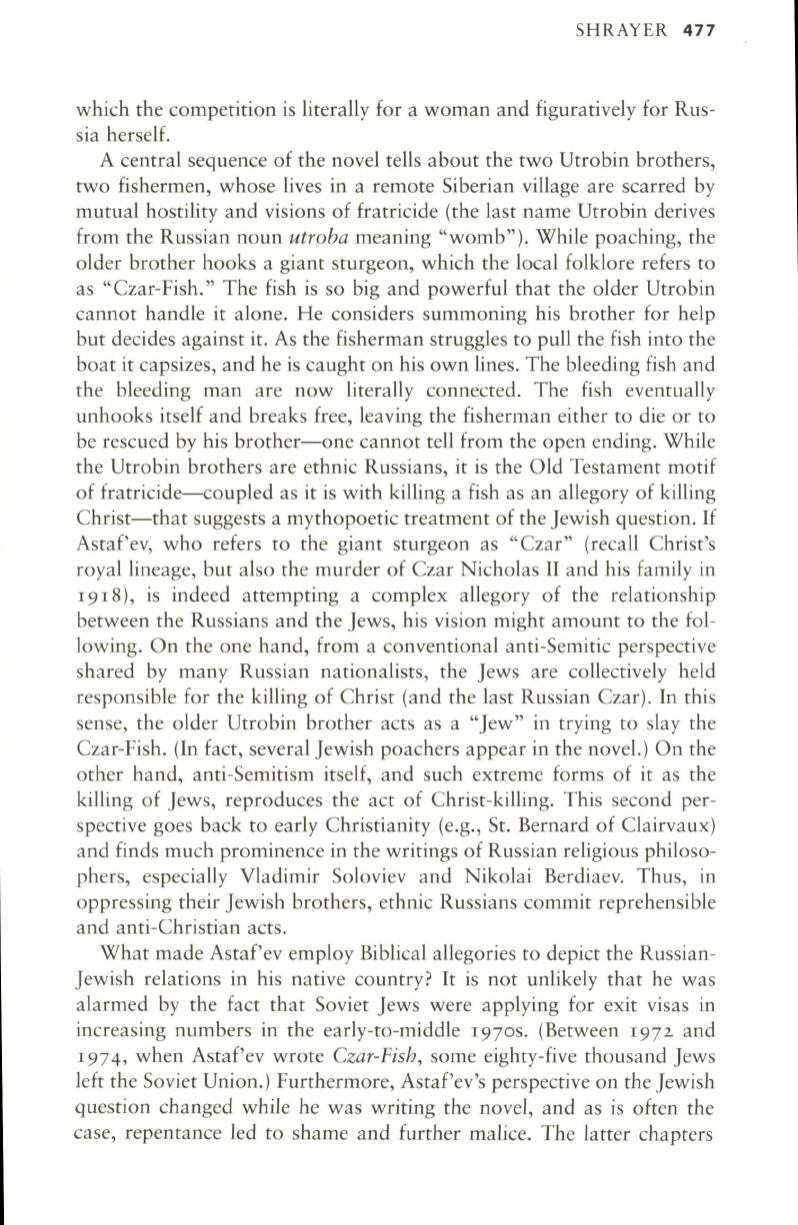
SHRAYER
477
which the competition is literally for a woman and figuratively for Rus–
sia herself.
A central sequence of the novel tells about the two Utrobin brothers,
two fishermen, whose lives in a remote Siberian village are scarred by
mutual hostility and visions of fratricide (the last name Utrobin derives
from the Russian noun
utroba
meaning "womb"). While poaching, the
older brother hooks a giant sturgeon, which the local folklore refers to
as "Czar-Fish." The fish is so big and powerful that the older Utrobin
cannot handle it alone. He considers summoning his brother for help
but decides against it. As the fisherman struggles to pull the fish into the
boat it capsizes, and he is caught on his own lines. The bleeding fish and
the bleeding man are now literally connected. The fish eventually
unhooks itself and breaks free, leaving the fisherman either to die or to
be rescued by his brother-one cannot tell from the open ending. While
the Utrobin brothers are ethnic Russians, it is the Old Testament motif
of fratricide-coupled as it is with killing a fish as an allegory of killing
Christ-that suggests a mythopoetic treatment of the Jewish question.
If
Astaf'ev, who refers to the giant sturgeon as "Czar" (recall Christ's
royal lineage, but also the murder of Czar Nicholas II and his family in
1918), is indeed attempting a complex allegory of the relationship
between the Russians and the Jews, his vision might amount to the fol–
lowing. On the one hand, from a conventional anti-Semitic perspective
shared by many Russian nationalists, the Jews are collectively held
responsible for the killing of Christ (and the last Russian Czar). In this
sense, the older Utrobin brother acts as a "Jew" in trying to slay the
Czar-Fish. (In fact, several Jewish poachers appear in the novel.) On the
other hand, anti-Semitism itself, and such extreme forms of it as the
killing of Jews, reproduces the act of Christ-killing. This second per–
spective goes back to early Christianity (e.g., St. Bernard of Clairvaux)
and finds much prominence in the writings of Russian religious philoso–
phers, especially Vladimir Soloviev and Nikolai Berdiaev. Thus, in
oppressing their Jewish brothers, ethnic Russians commit reprehensible
and anti-Christian acts.
What made Astaf'ev employ Biblical allegories to depict the Russian–
Jewish relations in his native country?
It
is not unlikely that he was
alarmed by the fact that Soviet Jews were applying for exit visas in
increasing numbers in the early-to-middle 1970s. (Between 1972 and
1974, when Astaf'ev wrote
Czar-Fish,
some eighty-five thousand Jews
left the Soviet Union.) Furthermore, Astaf'ev's perspective on the Jewish
question changed while he was writing the novel, and as is often the
case, repentance led to shame and further malice. The latter chapters


